New Equipment Reviews (Mar. 1977)--A CONSUMER'S GUIDE
Micro Seiki DDX-1000: Lean and Classic
The Equipment: Micro Seiki DDX-1000 turntable system, a two-speed (33.33, 45 rpm) single-play, manual turntable plus control unit in metal case. Dimensions: 17 1/2 by 17 1/2 inches (top), 5 inches high plus clearance for arm adjustment accessibility; control unit, 6 3/4 by 3 3/4 inches (top), 3 1/4 inches high plus clearance for controls: approx. 3-foot interconnect cable. Price: $600. Warranty: "limited," two years parts and labor.
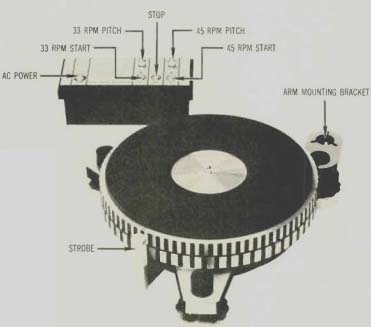
Manufacturer: Micro Seiki Co. Ltd., Japan; U.S. distributor: Teac Corporation of America, 7733 Telegraph Rd., Montebello, Calif. 90640.
Comment: If a turntable were distilled to its irreducible minimum, what would be left? Presumably there would have to be a platter on which the disc rides, plus some means for guiding and supporting the cartridge as the stylus performs the exacting task of tracing out the grooves. When you look at the Micro Seiki DDX-1000, that's all you see: a platter and an arm. Of course, there has to be more to the product, but its appearance tells a lot of its story. The emphasis is on elegantly refined basics.
An astute observer would notice that the vertical stripes that decorate the outer rim of the platter constitute a strobe pattern. Illumination for it comes from a neon lamp enclosed in a small outboard pod and driven by its own oscillator-which the manufacturer claims is almost ten times as accurate as an AC-power-line reference. Control of the unit is by means of an external module connected to the main section by an umbilical cord. The mounts for tonearms (you can use as many as three) are integral with the adjustable feet that support the turntable and isolate it from external vibrations.
Accuracy of speed as measured by CBS labs is excellent. Set to either 33 or 45 rpm with an initial supply voltage of 120 VAC, the turntable shows no measurable deviation at 105 or 127 VAC. The range through which the speed can be varied exceeds the ±6% (equivalent to about a semi tone sharp or flat) specified by the manufacturer at both 33 and 45 rpm. Stability of movement is on a par with speed accuracy, with the lab data substantially confirming the 0.025% claimed for wow and flutter. Similarly, rumble is suppressed by slightly more than 63 dB as measured using the CBS ARLL weighting. The motor torque and servo action of the DDX-1000 combine to provide locked speed in less than two seconds (one revolution at 33) after turn-on.
No tone arm is supplied, and the AX-1 mount accepts thirty-five of the more popular arms, with the notable exception of the SME-3009, for which a special mount (AX-2) can be ordered. Micro's own MA-505 tonearm, which costs an additional $150, is adjustable for height, vertical tracking force, and antiskating force while a disc is being played; overhang is adjustable as well.
--------- Preparation supervised by Robert Long and Harold A. Rodgers Laboratory data (unless otherwise noted) supplied by CBS Technology Center. --------------
---------------
REPORT POLICY: Equipment reports are based on laboratory measurements. Unless otherwise noted. test data and measurements are y Center. Stamford. Connecticut. a division of Columbia Broadcasting System Inc , one of the nation's leading research organizations The choice of equipment to De tested rests with the editors of HIGH FIDELITY Manufacturers are not permitted to read reports in advance of publication, and no report. or portion thereof, may be reproduced for any purpose or in any form without written permission Of the publisher All reports should be construed as applying to the specific samples tested neither HIGH FIDELITY nor CBS-technology Center assumes responsibility for product performance or quality.
------------
A turntable that is doing its job properly makes for an anticlimactic listening test, and so it was with the Micro Seiki. We soon found ourselves taking the performance of the unit completely for granted. The multiple-tone-arm feature is a big plus, as it allows easy A/B testing of phono cartridges and tone arms. It even allows those who are super-fussy to reserve certain arm /cartridge combinations for particular types of music. One minor point troubles us a little: There is no dust protection supplied with the turntable--although there are not many surfaces where dust can collect.
Obviously, a turntable at this price is not Everyman's bargain, but the engineering and construction that one has a right to expect for this much money are there without a doubt. The DDX-1000 has features that are unique in our experience, and its striking appearance is a direct result of the engineering thought that has gone into it.
+++++++++
Advent's 300 Receiver: Simple Is Beautiful
The Equipment: Advent 300 stereo FM receiver in metal case.
Dimensions: 15 7/8 by 3 1/2 inches (front panel), 9 7/8 inches deep plus clearance for controls and connections.
Price: $259.95. Warranty: "limited," three years parts and labor. Manufacturer: Advent Corporation, 195 Albany St.. Cambridge, Mass. 02139, USA.
Comment: If it were possible to devise a performance-to-appearance ratio for audio products, those of Advent Corporation would, in all likelihood, be strong contenders for top honors. It's not that they don't look good, but that there has been no attempt to make them into sculptures.
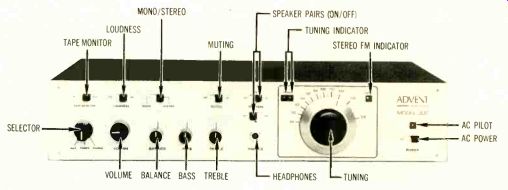
The value (and thus the cost) has been put inside the box and is directed at the consumer's ears, not his eyes. And, typically, the resulting sound has been very good. This is the tradition that the 300 springs from and is meant to advance-and as far as we are concerned the advance has been made.
The FM section is Spartan in its simplicity and has nary a meter in sight. Channel-center tuning is accomplished and very effectively-by setting a pair of light-emitting diodes (one indicates "too high," the other "too low") for equal brightness. Antenna rotation for minimum multi-path is done by ear-even the scope outputs are missing.
But, as the CBS data show, the goodies are there. The 1 1/4-dB capture ratio, comparable to that of fa: more expensive equipment, will help a lot in getting rid of that multipath, and the alternate-channel selectivity ',74 dB) falls in the good-to-excellent class. Suppression of stereo noise by 50 dB is accomplished with an RF input of just over 39 dBf, a signal level easily come by in urban and near-urban environments. Total harmonic distortion (which includes miscellaneous spurious products as well as distortion) is kept well in check, even at 10 kHz, where it can often be trouble some. Separation could almost be mistaken for that of a super-tuner. In fact, when reasonably strong signals are available, it is amazing how closely the FM sound of the Advent resembles that of tuners-without a preamp and power amp-whose prices are close to twice as much.
Perhaps the most striking feature of the 300 is its new phono preamp circuit. Its measurements are respectable enough (signal-to-noise ratio of 65 1/2 dB re full output, equivalent to 76 1/2 dB noise suppression re the conventional 10 millivolts; 100-millivolt overload; RIAA equalization accurate to within ±1 dB, 20 Hz to 20 kHz despite a non-defeatable rumble filter), but conventional measurements don't tell the whole story. The key question is: What will it sound like with a cartridge rather than a test generator connected, when it has to operate with a complex source impedance? Advent's engineers have studied this matter in depth and have designed the circuit for minimal impedance interaction. We found that an otherwise fine pickup that seemed somewhat shrill was much smoother than we had thought possible--when it was connected to the Advent preamp. This tends to support the company's boast that the 300 will audibly surpass many far more ex pensive units.
Of all the features of a receiver, power is probably the most costly, and by today's standards the output of this model appears modest. But realistically the 11 3/4 dBW (15 watts) per channel--40 Hz to 20 kHz at 0.5% distortion offered is perfectly adequate for most listening. With moderately efficient speakers, we were able to generate substantial sound pressure levels before clipping set in. And the recovery from clipping, an important consideration in a small amp, is instantaneous and graceful. Had Advent chosen to rate the power section a tiny 13/4 dB lower, at 10 dBW (10 watts) per channel, the power bandwidth (FTC style) would extend 20 Hz to 20 kHz and distortion diminish to less than half the rated amount. Thus the 300 has substantially half the sonic output capability of a good-quality 20-dBW (100-watt) per channel power amp. If you must have more than this, removal of two jumpers makes the preamp output accessible.
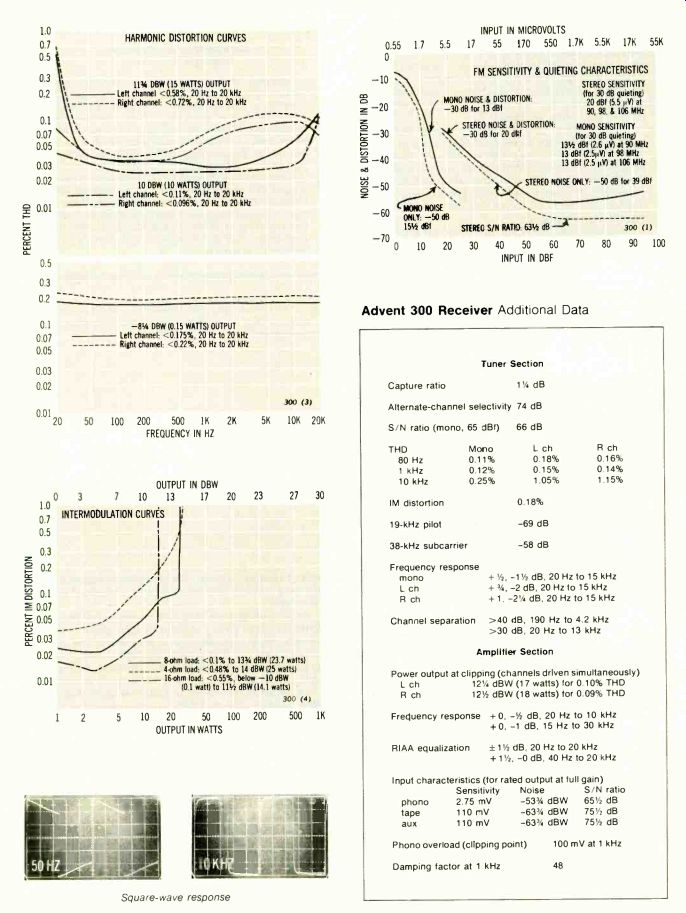
--------- Advent 300 Receiver: Additional Data.
These jumpers, connecting PRE-OUT and MAIN-IN pin jacks, are on the back panel, which is generally as spartan as the front. There is only a 300-ohm FM antenna input for example (if you use 75-ohm lead-in, you can couple it to the 300 via a balun transformer), and there is a single (switched) AC convenience outlet. There is one "extra," however; an 18-volt DC output that can be used to power the Advent mike preamp.
The basic simplicity of the control section is consistent with the principal features of the unit. Tone-control and LOUDNESS responses seem well judged, as are the FM muting and automatic stereo switching.
The design is, over-all, economical and without frills. Advent's announced intention with the 300 is to make a receiver that, within its power capability, sounds as good as anything available at any price. While we cannot substantiate that claim--it is, after all, a partially subjective one we cannot dismiss it as untenable either. And that, considering the price of the product, constitutes a remarkable accomplishment.
----
Cartridge-Preamp Interaction:
Tracking Down a Glitch In our review of the Sonus Blue Label cartridge (September 1976), we complained of an edginess that creeps in at high frequencies. At the time we investigated the matter carefully, playing the cartridge through several preamps--including the phono section of the Crown IC-150A-that had been giving us excel lent results. We were delighted to find, therefore, that connecting the Sonus Blue to the Advent 300 receiver virtually banished the edginess.
Comments from users suggest that the Advent is not the only preamp with which the Sonus can produce similar results. Accordingly, we would revise our conclusions about the Sonus and say that the excellent performance at lower frequencies extends to the highs as well as long as a compatible preamp is used.
--------------
++++++++++++++++++++++++
Stax SR-44: Sounds like a Dream
The Equipment: Stax SR-44 Earspeaker, an electrostatic stereo headphone system with adapter fcr connection to loudspeaker terminals. Dimensions: (adapter box) 3 1/2 by 2 1/2 inches (front panel), 63/4 inches deep plus clearance for controls and connections; weight: (headset) 7 ounces, excluding cord. Price: $85. Warranty: "limited," one year parts and labor. Manufacturer: Stax Industries, Ltd., Japan; U.S. distributor: American Audioport, Inc., 1407 North Providence Rd., Columbia, Mo. 65201.
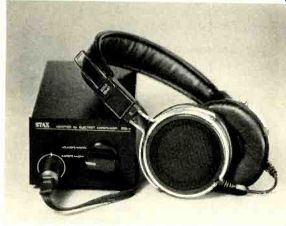
Comment: The Stax SR-44 headset is similar to the SRX MK. 3 (HF, March 1976) in principle and operation except that an electret is used to provide the internal electrostatic field for the drivers. This allows a considerable simplification in the adapter unit-which now needs only to step up the driving signal to the requisite high voltage and provide protection against overload-and allows a dramatic reduction in price. The SR-44 is of fairly high efficiency and, while it must be connected to a loudspeaker output rather than a headphone jack, works very well with a modest amount of amplifier power. Rated maximum output is 110 dB sound pressure level, enough to fry your ears if you're not careful.
The ear pads of these fairly light phones are exceedingly comfortable and form a sufficiently tight seal to the ear without undue pressure. The drivers are of the open-backed variety and thus provide little attenuation of external sounds. They do, however, very effectively relieve the feeling of partial deafness that one often experiences with a headset when the level in one channel drops markedly below the other. The cord that connects the adapter to the headset is a bit more than 8 feet long and provides ample freedom of movement. The color-coded cable that connects to the amplifier is about 3 feet long-a trifle skimpy, in our opinion, since extending it would require splicing.
We would have preferred a set of input terminals that allow the user to connect the length of cable he needs. The loud speaker terminals pre-empted by the SR-44 are duplicated on the back of the adapter; they and the cable seem adequate for anything short of extremely inefficient speakers driven by a monstrously powerful amp.
According to data provided to us by American Audioport, the frequency response of this headset lies, with two exceptions, well within the range that would be interpreted by the average ear as flat-that is to say, without unnatural coloration. We did not seek to prove or disprove this except by listening, and what we heard was superb. Music was re produced with a clarity and immediacy that was astonishing and that led us to prolong the testing session simply for pleasure. One of the exceptions alluded to above is a slight rolloff that begins at about 80 Hz and reaches a mere 2 dB down at 20 Hz. If it bothers you-we hardly noticed it except on test signals--it is easy to equalize out, for the SR-44 is as free of audible bass distortion as any head set we have ever heard.
The other exception is a dip a little more than an octave wide centered just above 3 kHz. As the importer indicates, this dip, far from being troublesome, has the effect of sup pressing a good deal of the noise and scratchiness that contaminates just about all program material to some degree and that becomes particularly noticeable in head phones. We found that we prefer the sound of the SR-44 over that of some other headsets that may be technically more accurate but that tend to be merciless in exposing the peccadillos of the program. This is a headset that will not make you hate your record collection-in fact, quite the contrary.
One of the perennial problems of headphone listening is that unless the program material is specially prepared binaurally recorded-the spatial presentation is not really natural. This applies to the Stax phones too, but there is a difference. The music seems to come from inside your head, but so vividly that it is like a dream. The effect is close to hypnotic. We can't guarantee that the SR-44 head set will sound that way to you, but if headphones are your thing, we do suggest that you try it. You may be in for quite a treat.
----------------
A Note on Headphone Response
Flat frequency response is one of the basic shibboleths of high fidelity-justifiably so in the case of electronics, in which it is possible to measure from the input to out put terminals and verify that the signal that comes out is substantially the same as what went in except for de sired changes, in amplitude, for instance. For loud speakers and headphones, however, this criterion simply does not apply. As one expert has pointed out, the phrase "output terminals" does not have any distinct meaning for a loudspeaker. The output of a headphone is clearly defined, but since the manner in which the drivers couple to the ear effectively bypasses the natural "signal processing" performed by the outer ear --which has anything but a flat frequency response the measurement conundrum is about as bad as it is for loudspeakers. Complicating matters still further is the fact that no two ears are the same-not even the left and right ears of the same person.
Some research has been addressed to this point, and a set of limiting curves, between which the response of a properly made headphone should lie, has been deter mined. This is helpful to the designer, but it does not tell how any particular headset will sound to you. As with loudspeakers, the only way to tell how well a head phone reproduces music is to listen. Test reports are useful guidelines, but the final decision must be yours.
All we are using as test equipment is our ears.
------------------
++++++++++++++
Yamaha's C-2, a Preamp for Purists
The Equipment: Yamaha C-2, a stereo preamp/ control center, in metal case.
Dimensions: 17 1/2 by 2 7/8 inches (front panel); 12.4 inches deep plus clearance for controls and connections. Price: $650. Warranty: "limited," three years parts and labor.
Manufacturer: Nippon Gakki Co., Ltd., Japan; U.S. distributor: Yamaha International Corp., P.O. Box 6600, Buena Park, Calif. 90620.
Comment: In many areas of art and design there seems to be a polar conflict between generative principles: classical vs. romantic, strict form vs. free form, Apollonian vs. Dionysian. If this dichotomy were to be applied to audio equipment, and to preamps in particular, a complex, feature-laden control panel might be thought romantic, and a spare set of controls-each impeccable in its operation-called classic. Yamaha's C-1 would fall into the first class, and the C-2 into the second. Each is a tour de force, the latter the more difficult to succeed with, in our opinion, since the romantic approach is more immediately appealing. Yet as the C-2 demonstrates, the in-depth probing required for the appreciation of classicism may have even richer rewards.
In much equipment that is generally conceded to have excellent signal-to-noise ratios, the distortion of the Yam aha would be unmeasurable: The noise would mask it. And the residual noise is at the vanishing point. According to ...
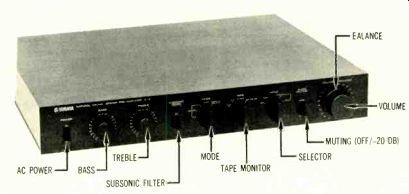
----- Yamaha C-2 Preamp, Additional Data
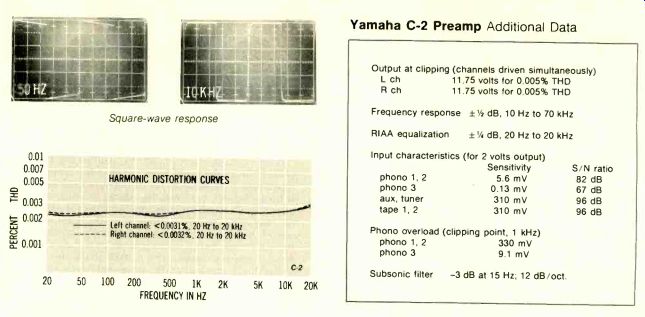
------ Square-wave response
... the CBS lab data, the clipping point of the preamp is at 11.75 volts, a level sufficient to drive any power amp that we know of to produce neatly flat-topped waveforms. Total harmonic distortion at clipping is 0.005%, equivalent to -86 dB with respect to the desired signal. When the output level is held to a more reasonable 2 volts, THD averages 0.0025% (-92 dB) across the audio band, with a worst-case figure of 0.0032% (-90 dB). This substantially confirms the manufacturer's specification (which presupposes slightly different conditions of measurement). The specification for IM distortion could not be confirmed, however: whatever IM there is lies below the limits of the test equipment. Less than 0.01% is all the lab could report.
Noise levels in the C-2 are, again, superlatively low. Despite the fact that the gain of PHONO 1 and 2 are a bit higher than usual (at 51 dB), the S/N ratios for those in puts measure 82 dB re a 2-volt output. Referenced to the conventional 10-millivolt input, this is equivalent to 87 dB.
Clipping at 1 kHz occurs with a 330-millivolt input. PHONO 3, a pre-preamp (or "head amp") for moving-coil cartridges, has a total gain of 84 dB and an S/N ratio of 67 dB, equivalent to a staggering 105 dB re a 10-millivolt in put. Obviously so high a reference input is somewhat un realistic for the intended application-though the overload point at 1 kHz is 9.1 millivolts-but it does show how extremely quiet the pre-preamp is. The high-level inputs all have S/N ratios of 96 dB. (Lest the eagle-eyed seize on the apparent discrepancy between our measurements and Yamaha's claims, we note that our noise data, unlike those of the manufacturer, are unweighted.) The equalization stages of the C-2 are on a par with the gain stages. The RIAA curve is virtually perfect from 20 Hz to 20 kHz, and the tone controls are within 1/2 dB of their intended responses. The subsonic filter, a useful tool in warding off the effects of recorded rumble and warped discs, is 3 dB down at 15 Hz and rolls off at 12 dB per octave, just as claimed. Its effect in the audible bandpass amounts to-11/4 dB at 20 Hz-which, of course, proved un detectable on program material.
Insofar as the C-2 projects its personality, it generates a ...
--------------------
About the dBW ....
We express output power and noise in terms of dBW-meaning power in dB with a reference (0 dBW) of 1 watt. We repeat herewith the conversion table so that you can use the advantages of dBW in comparing current products with those we have reported on in the past. You can, of course, use the figures in watts that accompany the new dBW figures for these comparisons, but then you lose the ability to compare noise levels for outputs other than rated power and the ability to figure easily the levels to which specific amplifiers will drive specific speakers--as explained in the June 1976 issue. If you do not have that issue and would like a reprint of the full exposition, send 250 ( U.S.) to: dBW, c/o High Fidelity Magazine, The Publishing House, Great Barrington, Mass. 01230.
WATTS dBW WATTS dBW WATTS dBW 1.00 0 10.0 10 100 20 1.25 1 12.5 11 125 21 1.6 2 16 12 160 22 2.0 3 20 13 200 23 2.5 4 25 14 250 24 3.2 5 32 15 320 25 4.0 6 40 16 400 26 5.0 7 50 17 500 27 6.3 8 63 18 630 28 8.0 9 80 19 800 29
--------------------------------
... sense of restrained purism. It does not overwhelm one with its controls, which are in fact quite basic. The design of the controls encourages the user to consider their ef fects carefully: Who can twist away thoughtlessly at a tone control calibrated near its center in 1/2 dB increments? We suspect that the C-2 will help a listener to learn how good his hearing is and become still more discriminating.
If anything about the unit leaves us less than totally ec static, it is the design of the levers. It is difficult to tell at a glance, against the black front panel, whether they are Jp or down. This led us in one instance to engage the 20-dB attenuator and wonder later why the volume control had to be advanced so far before a reasonable listening level was obtained.
There is no position for dubbing between the two tape decks the C-2 is capable of handling, but the tape switching does include one refinement we have never seen be fore: a REC-OUT-OFF position that kills the feed to the recorders and thus prevents any noise or other adverse interaction between them and the preamp when you are not actually recording. Should extension loudspeakers be de sired, the C-2 is equipped to drive two power amps.
But what is almost eerie about the Yamaha is that, as far as hearing is concerned, it simply is not there. If you hear a hiss when you turn the volume up high, it is coming from the input source, not from the preamp. If the tonal balance seems strange, the C-2 will help you straighten matters out, but the blame will have to fall on some other part of your system. And you can forget clicks and pops, except from program material-the preamp barely makes those, even when the SELECTOR is switched. To within a fraction of a decibel the C-2 does only what it is ordered to, and with its smooth-acting controls it accepts directions readily. A more elegant and convincing argument for refined basics would be difficult to imagine.
++++++++++++++++++++++++++++
Paradox TA-12: Leviathan So Sweetly Sings
The Equipment: Paradox TA-12, a floor-standing loud speaker system in wood enclosure. Dimensions: 18 by 34 inches (front), 16 inches deep. Price: $330. Warranty: "limited," five years parts and labor. Manufacturer: Sonic Energy Systems, 6914 Harwin Dr., Houston, Tex. 77036.
Comment: Remember Willie the Whale, who surged up mightily from the deep and opened his cavernous mouth, not-as we might have feared-to overwhelm, but rather to charm with his refined operatic voices? Well, the Paradox TA-12 is a little like that. After wrestling two of these 75-pound monsters out of their shipping containers and hooking them up, we expected that their sound would fairly bowl us over and were at first a little disappointed when it didn't. A little more listening left us convinced that we were hearing music with uncommon clarity. That's not an unusual turn of events; colorless speakers may seem bland at first, but often prove the most pleasing.
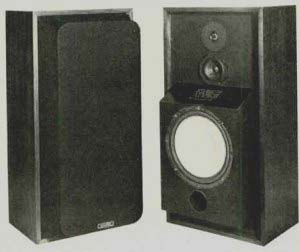
One thing that makes the Paradox seem subdued initially is its rather low efficiency-unusually low for a ported design. According to CBS labs, a 0-dBW (1-watt) input of pink noise, 250 to 6,000 Hz, results in an acoustic output of close to 87 dB sound pressure level at 1 meter on axis in the anechoic chamber. The dynamic range extends to quasi-discotheque level, however, if you have the amplifier power. At the onset of serious distortion, the speaker produces a continuous SPL of 105 dB from an input of 20 dBW (100 watts). Under transient conditions, measured with a pulsed input signal, the maximum usable output is 111 1/2 dB SPL from a drive power of 26 1/2 dBW (450 watts) peak. Second- and third-harmonic distortion remain quite low until continuous levels of 100 dB or so are surpassed.
Nominally the TA-12 is an 8-ohm speaker, and its impedance curve remains at or above this value everywhere except for a small region around 1 kHz, where it falls to 7 ohms. Accordingly, two of these units connected in parallel represent an acceptable load for typical solid-state amps.
Almost coincident with the bass rise in the impedance curve, as one might expect, is a rise in the omnidirectional power response of about 4 dB, measured anechoically.
Though this indicates slightly underdamped behavior of the woofer, it is not obtrusive in normal listening. Actual bass response is a function of the listening room as well as the loudspeaker. Low-end output, in our opinion, is sufficient to allow the reinforcement that might be gained from corner placement to be sacrificed in favor of the smoothness that can result from placing the speaker clear of the corner in a spot where the distances from the woofer to the three nearest room boundaries (floor and two walls) are irregular.
From 100 Hz upward the power response is about as flat as any we have seen, tailing off by about 5 dB from 3 kHz to about 18 kHz. Interestingly, the omnidirectional, front-hemisphere, and on-axis response curves are close to parallel, indicating excellent dispersion. While this could indicate very little change in coloration as one moves off axis, such is in fact not the case. For other reasons, the Paradox TA-12 sounds best when heard from within a frontal sector about 60 degrees wide.
The Paradox, as the unusual geometry behind its stretch-knit grille might suggest to those in the know, is de signed to compensate for propagation delays between the drivers. (The manufacturer calls this Time-Alignment.) This characteristic, together with a specially designed crossover network, allows it to reproduce recognizably square wave-shapes, according to data from the manufacturer. While this ability may seem related to transient response (which is abundantly quick in any case), the most audible effect we could find seems to be the TA-12's ability to distinguish clearly between direct and reverberant sound in a recording. We could find no test that would at tribute this unequivocally to phase coherence alone (or at all), but this model is able to "dry up" an overly reverberant recording and glean from it a clarity and openness that we would not have suspected possible. A good deal of this pleasant effect is lost at listening positions far off axis, although a reasonable frequency balance is maintained.
The midrange and tweeter are provided with controls that are meant to be used within a range of ±3 dB (they go from about + 3 dB to completely off), which should be sufficient to match the speakers to most rooms.
If it is not clear by now that the TA-12 impresses us very favorably, let us remove any doubt: It does. Its sound fairly sparkles (some might find it just a trifle forward) without being cold or clinical. Stereo imaging is outstanding, and the sense of transparency is such that one tends to forget the speakers are there. Some listeners judge that their sound outperforms their price. That doesn't surprise us not at all.
+++++++++++++++++++++++++
Realistic STA-2000 receiver
Realistic New Look-- Clean and Powerful
The Equipment: Realistic STA-2000, an FM/AM stereo receiver, in metal case with wood trim. Dimensions: 19 1/4 by 6/8 inches (front panel); 13.5 inches deep plus clearance for controls and connections. Price: $499.95. Warranty: "limited," two years parts and labor. Sole distributor: Radio Shack Division, Tandy Corp., 2617 W. Seventh St., Fort Worth, Tex. 76107.
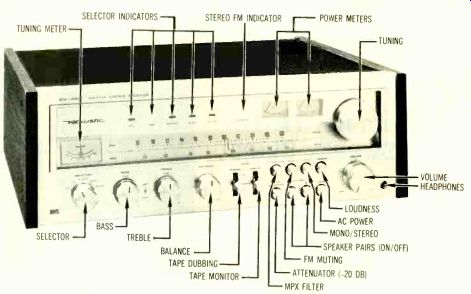
Comment: Even at first glance, the Realistic STA-2000 announces itself as a receiver to be reckoned with. It sports the current "clean look" and yet retains its own distinction and individuality. When you try to pick it up, it tests your muscle and hints at its own. And indeed the amplifier section, with its rated 18 3/4-dBW (75-watt) per-channel output capability, is a solid contender in the light-heavyweight class. Add to this a well-chosen array of highly functional controls and very competent FM and preamp sections, and the result is quite an attractive package.
The designers of the STA-2000 are to be complimented on their solutions to some of the human-engineering problems associated with styling of this type. Pushbuttons are large enough that there is no doubt whether they are in or out, and the generous throws provided in the levers make their disposition abundantly clear as well. Moreover, the buttons one is likely to push least often (POWER and SPEAKERS A and B) are provided with heavier spring loads than the others, giving the user the chance to reconsider before the deed is done. The dial is large and legible (thanks, in part, to its upward angling), the knobs have a good solid feel, and the power-output meters (an unusual feature in a receiver of any price) keep one aware of what is being demanded of the loudspeakers.
But the essence of the STA-2000 is not its convenience and styling; its heart, rather, lies squarely in its circuitry.
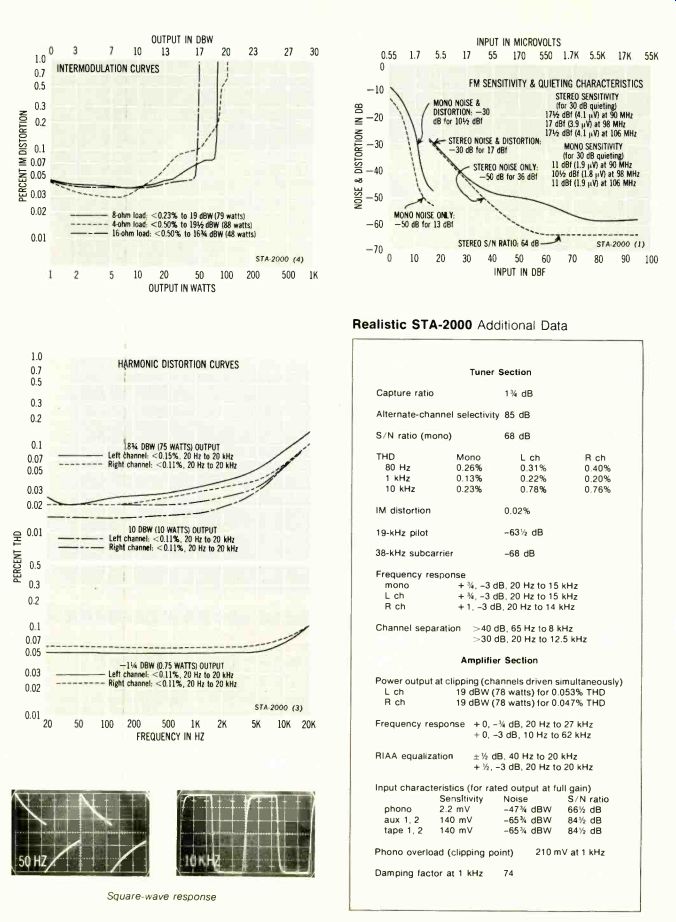
------- 4 Realistic STA-2000. Additional Data
------- Square-wave response
OUTPUT IN DBW
Putting the tuner section through its paces in the lab, CBS determined that the 50-dB quieting point for stereo FM reception is reached with an RF input of well under 38 dBf, a very low level. Distortion is held to suitably minute levels, even THD at 10 kHz, where many a receiver (or tuner) has been known to run into trouble. And the other cardinal specifications of the FM section-including alternate-channel selectivity, ultimate signal-to-noise ratio, capture ratio, and separation-place it solidly in the performance range to be expected in its price class. The sole exception is frequency response: Careful listening reveals some slight departures from impressive behavior both in stereo and mono. The multiplex blend control is effective in reducing noise from weak stereo stations, but the muting control does allow an occasional blip of interstation noise to slip through as the unit is tuned rapidly across the dial.
With noise figures rivaling those of many a separate component, the preamp section too shows its capability.
The phono stage is especially good in that its signal-to noise ratio, referenced to the conventional 10-millivolt level, is equivalent to nearly 80 dB. The overload point of this stage also is somewhat better than average. A low-end rolloff amounting to 3 dB at 20 Hz is apparent in the RIAA curve. This is not necessarily disadvantageous as it does offer protection against rumble and subsonic noise, but if it is intentional, we believe a defeat switch should have been provided.
The controls are unusually flexible: Bass and treble equalization for the two channels can be adjusted separately, and monitor and dubbing facilities are provided for two tape decks. The 20-dB attenuator button (useful while answering the telephone, say, without having to reset the volume) and the fact that switching transients from the SELECTOR are very well suppressed (there is a slight delay before the audio comes on) represent nice touches.
If any part of the S-A-2000 approaches overachiever status, it is the power amplifier. It meets its specifications for power and distortion (0.25%) with a good deal to spare and offers sonic performance preferable to that of at least one 20-dBW (100-watt) per-channel separate that we know of-and at a far more attractive price. It retains its low distortion down to revels below 0 dBW (1 watt), where most listening is done, and draws attention to itself only by the ample power held in reserve for reproducing peaks. Its damping factor is more than sufficient to keep the loud speakers in check at low frequencies.
The conclusion, then, is inescapable: The Realistic STA 2000 must be taken seriously, both in performance and appearance. It has eschewed seductive frills in favor of solid performance and acquits itself creditably. Its standing relative to other members of its price class is fully competitive. This is a receiver that neither the competition nor the value-conscious buyer should ignore.
+++++++++++++++++++++++++++
Dual CS-704, a Very Together Turntable
The Equipment: Dual CS-704, a two-speed (33, 45 rpm) direct-drive turntable with integral tone arm, wood base, and dust cover. Dimensions: 16 1/4 by 14 1/2 inches (top): 6 inches high with dust cover closed, 151/2 inches clearance required with cover fully open. Price: $310. Warranty: "limited," one year parts and labor. Manufacturer: Dual, W. Germany; U.S. distributor: United Audio Products, Inc., 120 S. Columbus Ave., Mount Vernon, N.Y. 10553.
Comment: The word "together" in the headline of this re port is, clearly enough, meant to be taken in a figurative sense. It can, however, be applied in a literal sense as well: The CS-704, in contrast to some of the turntables That we have seen, which could almost be called kits, arrives al most completely assembled. Remove the packing material, loosen three screws. drop the platter into place, se cure the dust cover. Very refreshing. There is the inevitable nuisance of mounting a cartridge-something we regard as the price of freedom of choice-but even here the Dual offers as much convenience as any unit we can think of, partly because its tone arm is adjustable in height.
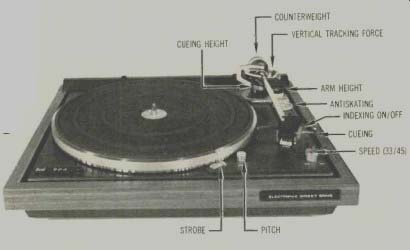
The CS-704 is utter simplicity to operate. Lift the tone arm, move it to the left, and the system turns itself on.
Continue the leftward movement until a slight resistance ..
CUEING VERTICAL TRACKING FORCE COUNTERWEIGHT ARM HEIGHT ANTISKATING INDEXING ON/OFF CUEING SPEED 03/451 STROBE PITCH
... is felt, and you're cued for a 12-inch disc: push on to the next point of resistance, and a 7-incher is cued. This indexing feature can be defeated if you want. Release the cueing lever at any point (the arm must be over the platter or the lever just springs back harmlessly), and the disc starts to play. At the end of a side, the platter stops and the arm is raised. There is almost no way to make an error that will damage either record or stylus.
Lab testing, too, is taken right in stride by the CS-704.
CBS found that either speed, once it is set with power line voltage at 120 VAC, remains exact (within the limits of measurement) when the voltage is 105 or 127. The PITCH control offers a little more than a quarter tone of adjustment both ways at both speeds. Excellent short-term rotational stability is documented by an average peak flutter (ANSI/ IEEE weighting) of 0.03%, with an instantaneous peak value of 0.07%. Rumble, suppressed by 62 dB using the CBS ARLL weighting, falls in the good-to-excellent class and is virtually inaudible.
Besides is adjustable height (which allows a cartridge to be mounted for optimum vertical tracking angle without the use of shims), the tone arm incorporates some interesting features. A mechanical filter decouples the counter weight so as to damp the tone-arm/cartridge resonance. The resonant frequency measures 71/2 Hz (using the Shure V-15 Type III pickup), a figure that we would ordinarily consider dangerously close to the warp region. But in the Dual the resonance is damped to a mere 1-dB rise, which makes the point very nearly moot. And in practice, the CS-704 handles warped records like a champ.
Friction in the tone-arm bearings is negligible for both horizontal and vertical movement, and the stylus-force mechanism is as accurate as the lab test equipment at any setting from 1 to 3 grams. (Above or below that, who cares anyway?) The antiskating system increases force linearly with setting on all scales; Dual's calibration for Shibata and similar styli (the scale labeled CD-4) is virtually identical to that for ellipticals, with values about 13% lower delivered by the calibration for spherical styli.
Our listening test of the CS-704 led to an interesting observation: The excellent damping provided by the antiresonance filter results in less recorded rumble and low-frequency chaff being transferred through the stylus and pickup to the preamp. This translates into a small but perceptible increase in the over-all clarity of sound. The over hang adjustment is slightly limited in range, yet the worst discrepancy in fit we found seemed without audible effect.
And the instructions don't show how to adjust cueing height (our callout photo does, and, we are told, the manual's oversight will soon be fixed).
From its basic performance to its human engineering, the Dual CS-704 strikes us as a product well conceived and well realized. We would not hesitate to trust it with our most beloved records and find, in fact, that it makes our fumble-fingeredness much less of a hazard. Beyond that, it has let us hear that many of our discs are just a bit better than we had thought. It is a fine job all around.
+++++++++++++++++++
Dynaco's Stereo 300 Amplifier--Muscle and Lots of Moves
The Equipment: Dynaco Stereo 300/A, a power amplifier with optional conversion for four-channel operation or low impedance loads, in metal case with wood end blocks. Dimensions: 18.5 by 7.5 inches (front panel), 14 1/2 inches deep. Price: wired (Stereo 300 /A), $599. Options: Stereo 300 kit, $399; QSA-300 quad /stereo kit, $399; MC-3 illuminated-meter kit for QSA-300, $125; QSA-300M /A wired quad/stereo amp with meters, $699.
Warranty: Stereo 300/A, "limited," one year parts and labor; Stereo 300, "limited," one year parts. Manufacturer: Dynaco, Coles Rd., Box 88, Blackwood, N.J. 08012.
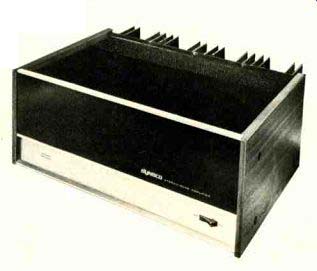
Comment: The Stereo 300 is really two stereo amplifiers four channels of amplification and two power supplies mounted on a single massive chassis. Operated singly, each of the four channels is rated at 19 dBW (75 watts); they can be combined to form two channels rated at 22 dBW (150 watts). Distortion in all cases is rated at less than 0.25% total harmonic or IM, 20 Hz to 20 kHz, a level that CBS could not force the amp to approach, even by driving it to clipping. Reasoning that stereo operation uses all four amps and that at least as many users will opt for two-channel operation as for four, we decided to test in the former mode.
The Dynaco strikes us as conservatively yet economically designed. Rated power is exceeded by a modest mar gin that amounts to less than 1 dB and thus constitutes a production safety margin rather than significant head room. This seems entirely proper and realistic, since an additional 3 dB would require a doubling of output power.
The moral: If you need a bigger amp than this, you had better look for something really big if you expect to hear the difference. The true conservatism is in the exceedingly small distortion (less than 0.1% worst case) alluded to earlier. This is one of the cleanest power amplifiers we can re call-both in its lab performance and its sound.
Part of the job of a power amp is to control the loud speakers, and this the Stereo 300 does exceedingly well despite the fact that the damping factor does not seem astronomical. Actually, if the DC resistance of loudspeaker voice coils is taken into account, a damping factor greater than the 31 measured for this unit is of negligible benefit.
More to the point, this figure suggests that the amp is reasonably clean under open-loop conditions and that negative feedback has been kept modest. This, together with the high slew rate claimed by the manufacturer, suggests that there is little likelihood of any transient distortion.
A driving signal of just under 1.5 volts into 35,000 ohms, which is easily supplied by most preamps, produces rated output power, and signal-to-noise ratio is excellent at 104 dB, equivalent to less than-82 dBW of noise. Thus, there should be no problem using this amplifier even with efficient speakers. Frequency response is within 1/2 dB of flat from 20 Hz to 40 kHz.
To our way of thinking, the Stereo 300 is truly elegantly designed. There is performance aplenty, and all of it is where it counts; nothing has been wasted on frills or window dressing. Beyond that the unit is incredibly flexible. It can be used for quad, for bi-amping, for paralleled speakers (the low-impedance connection is fine with loads down to 2 ohms), for speakers stacked two per channel-you name it. (The internal wiring alterations are simple enough.) This looks like a lot of amplifier for a lot less money-particularly if you decide to build the kit-than you normally would expect to pay.
----------------
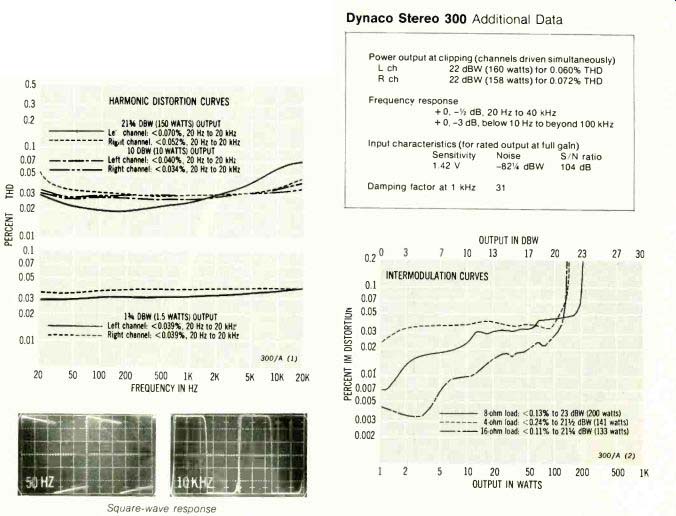
Dynaco Stereo 300
Additional Data: Square-wave response
++++++++++
Stereopillow, a Novel Way to Listen and Relax
The Equipment: Stereopillow, a personal listening system disguised as a full-size polyurethane foam pillow with replaceable gold velour cover. Dimensions: 27 by 17 inches, fairly plump. Price: $79.95. Warranty: "limited," one year parts and labor. Manufacturer: Yeaple Corp., 12255 University Ave.. Rochester, N.Y. 14607.
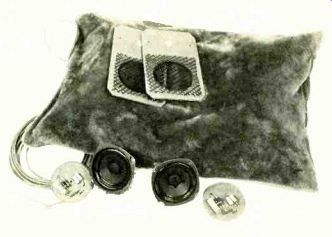
Comment: J. S. Bach wrote the Goldberg Variations for a harpsichordist (named Goldberg) whose patron reportedly suffered from terrible insomnia and whose job was to soothe his patron's nerves into somnolence. Modern technology being what it is, you now can relax on a very comfortable pillow and have the sounds of Bach's music (or anyone else's) bathe your ears in truly sybaritic fashion and it costs a lot less than keeping a harpsichordist on your staff.
The device that makes this possible by bridging the gap between loudspeakers and headphones is the Stereopillow. While headphones are clamped to the listener's ears and create a virtual sound field that follows every movement of the head, however slight, the Stereopillow positions its drivers about two inches away. Thus the sound field is independent of the position of the user's head; also the ear is close enough to the driver-in the "near field"-that extended bass response is possible.
Furthermore, room effects cannot color the perceived sound.
These advantages do not come quite free-the listener is required to keep his head in the right spot. But this is where the pillow part comes into play. It soothes, caresses, even seduces you into keeping your head where it should be, without insisting that you be careful or attentive.
Should you roll too far to one side, the increased volume on that side becomes the gentlest of reminders to turn back, and without spoiling the sense of stereo.
For at least some people, the stereo image does have its peculiarities, however. We-and those who assisted Js in the testing-generally find that the music seemed to come from behind. The designers suggest (and we agree) that the degree to which this effect is noticed depends on the shape of the outer ear and will vary from one person to an other. It is, in any case, not at all disturbing.
Trotting out some of our test records, we investigated the frequency response curve of the Stereopillow and found it smooth and impressively extended, especially into the bass regions. (The low end outperforms some very creditable loudspeakers we have heard-probably, in part, because of the freedom from room effects.) Generally, the response falls off with increasing frequency, dips a bit in the upper midrange, and develops a couple of minor peaks at high frequencies before the end of useful response, at 15 to 16 kHz. This agrees essentially with the manufacturer's claim. We find that the sound becomes a bit brighter and airier with a moderate treble boost-which the unit takes in perfect stride-at the electronics to which the Stereopillow is connected.
One thing that we particularly like about the Stereopillow is its low distortion. You can listen at levels loud enough to mask external sounds completely without muddying the sound. And clarity is maintained at low levels too; the dynamic range is just fine. Some of the sound, minus extreme highs and lows, projects into the room. At a distance of a few feet, however, the sound pressure level falls to 20 to 25 dB below that perceived by the user.
How good is the Stereopillow? The interaction with a listening device such as this is highly personal. We like the sound and the experience of hearing it via the Stereopillow, but it may not be for everyone. It certainly is worth a try if you are turned on to private listening in comfort. For more information contact the manufacturer, not us. We'll be busy checking out the possibilities of Stereopillows--for two.
++++++++++++++++++++++++++++
B&O's Iconoclastic Receiver
The Equipment: Beomaster 1900, a stereo FM receiver in metal case with wood trim. Dimensions: 21 1/4 inches wide; 2 1/2 inches high plus 51/2 inches clearance for top cover opening; 10 1/4 inches deep. Price: $495. Warranty: "limited," three years parts and labor, shipping partially paid.
Manufacturer: Bang & Olufsen, Denmark; U.S. distributor: Bang & Olufsen of America, 515 Busse Rd., Elk Grove Village, Ill. 60007.
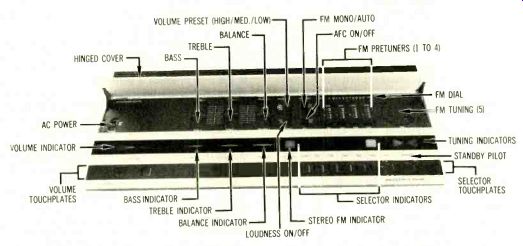
Comment: If you didn't know the Beomaster 1900 was a receiver, you probably wouldn't guess. As it sits there with its elegant low profile awaiting your touch, not a single control or indicator seems to be in sight, save perhaps a small light to tell you that the unit is in the STANDBY mode-if that's how you left it. Your touch is literally all that is needed to put it into operation, for the controls are a set of appropriately labeled wells that react to the contact of your finger. The touch controls allow a choice of PHONO, TAPE, or any one of five FM presets. Volume, which is preset to a de sired level-low, medium, or high, via a three-position switch-at turn-on, is adjusted by means of two touch controls, one to raise it, one to lower it. A system of lights gives
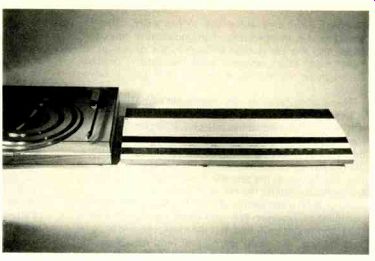
------- With the cover closed over the more esoteric controls--the
normal operating mode-the Beomaster 1900 makes a striking ensemble
with the Beogram 1900 turntable.
a visual indication of the volume setting. The less often used functions are controlled by an array of switches, sliders, thumbwheels, and the like, all of which are hidden behind a hinged panel on top of the receiver.
The power amp section of the Beomaster is rated at 14 3/4 dBW (30 watts) per channel, into an 8-ohm load, 20 Hz to 20 kHz, with total harmonic distortion of no more than 0.2% and IM distortion of less than 0.15%. The tests per formed by the CBS labs confirm that these specifications are met, with something to spare. Damping factor measures 76 at 1 kHz and, judging from the fairly tight bass response elicited from the speakers, remains high at low frequencies. Frequency response at 0-dBW output is essentially flat from 1 to 10 kHz. At the low end there is a gentle rolloff that begins in the region of 200 Hz and reaches -1 3/4 dB at 20 Hz and -4 1/2 dB at 10 Hz.
The preamp section is very good with respect to noise performance: The tape input has an equivalent input noise of-61 1/4 dBW, for a signal-to-noise ratio of 76 dB re full output; the phono section is 10 dB noisier, which is usual, and when its S/N ratio is referenced to the conventional 10-millivolt input, a very respectable 74 dB is obtained.
Phono overload level at 1 kHz is 54 millivolts, a lower-than-average figure. Equalization for RIAA response (measured by CBS as total departure from "flat" and hence including the amp's slight bass rolloff) shows a 1-dB rise at 20 kHz, a broad 1-dB dip centered at about 300 Hz, and a rolloff that begins at 50 Hz and reaches-22/3 dB at 20 Hz. This last characteristic may offer some protection against feedback and rumble from warped records and the like, but its slope is not steep enough to make it optimal for this purpose.
Tone control responses are normal, and the loudness contour seems reasonable.
The FM section has good sensitivity and noise performance and reaches the all-important 50-dB S/N ratio in stereo with a modest RF input of just under 38 dBf. The ultimate stereo S/N ratio measures an excellent 67 dB.
Distortion is well suppressed, although the familiar rise in THD at 10 kHz is apparent. Intermodulation is low, and the capture ratio is adequate. Automatic frequency control is available for all five of the tuner presets, and its use would seem advantageous, for there is some perceptible drift when it is switched off for any extended period.
Presets 1 through 4, which presumably will not be retuned often, are adjusted by means of thumbwheels and have dials that are a bit tricky to read. The fifth preset functions as the "main" FM control section and has a slightly larger, more legible dial and a more convenient tuning mechanism-a flat, rotating disc with a recess for one's fingertip.
Channel-center tuning is accomplished by setting a pair of lights for equal brightness. In our listening tests (for which we used B&O's own Beogram 1900 turntable and MMC 4000 cartridge), we found that the FM audio level was sufficiently higher than the phono level to give quite a jolt to the user who switches from phono to FM without reducing the volume-or engaging STANDBY for 10 seconds or so to let the volume readjust automatically to its preset level.
The MMC-4000 is not a particularly insensitive cartridge, so this effect will be noticed with other models as well. The highly efficient protection circuit, which returns the unit to STANDBY when power drain becomes excessive, will protect the output stage and any speakers of reasonable power capacity against actual damage, however.
The touch controls of the Beomaster are convenient and pleasant to operate and give a distinct aura of luxury. The volume control requires that the user become accustomed to the rate at which it shifts up or down when activated.
The preset switch referred to earlier is concealed under the hinged panel. Speakers and other outboard equipment are attached via DIN connectors, for which all the necessary adapters are provided. One stated purpose for using these connectors is to keep wires, plugs, and the like discreetly out of sight; another is to save space. In our opinion, the move succeeds in both respects.
Clearly the Beomaster 1900 is not your basic, everyday receiver. Its cosmetics are unusual (and the matching Beogram 1900 turntable makes for a visually stunning ensemble). Once one becomes accustomed to the innovative style of the model, operation is straightforward, and the sonic performance is certainly adequate for a receiver of this price class. Whether or not this is the receiver for you is a matter of taste-not only in sound and conveniences, but, to an unusual degree, in styling. The Beomaster has thrust its foot boldly forward; we doubt that your response to it will be neutral.
(Additional data on page 68)
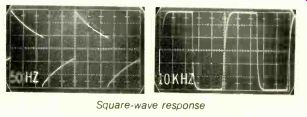
---------- Square-wave response

-------------- Beomaster 1900 --- Additional Data --- HARMONIC DISTORTION
CURVES
-------------
(High Fidelity, Mar. 1977)
Also see: